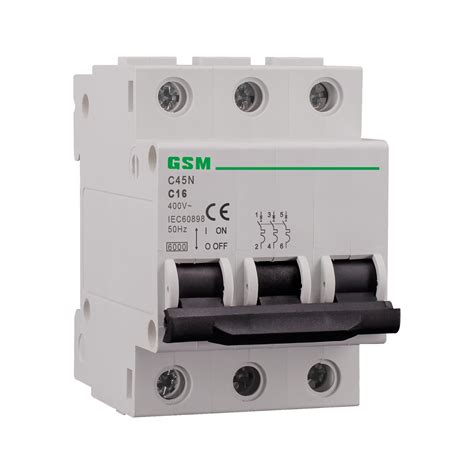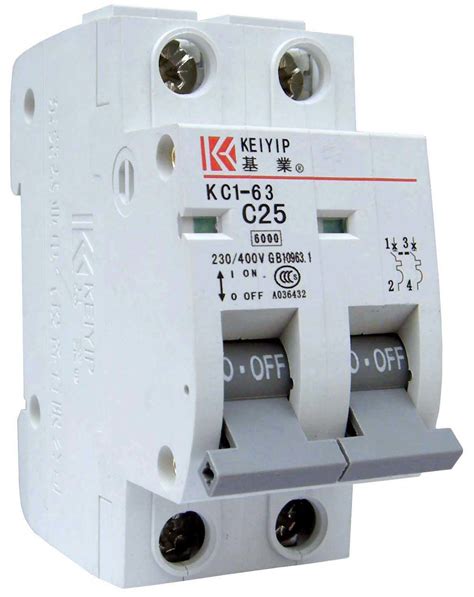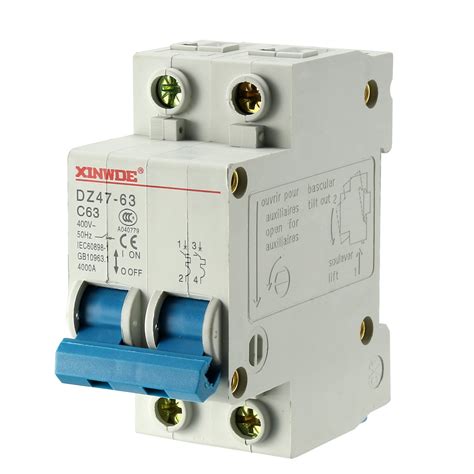What are Circuit Breakers?
Circuit breakers are essential components in electrical systems that protect against overcurrent, short circuits, and electrical overloads. They act as safety devices by automatically interrupting the flow of electricity when the current exceeds a predetermined level, preventing damage to electronic components, wiring, and other connected devices. Circuit breakers come in various types and sizes, each designed to handle specific current ratings and applications.
Types of Circuit Breakers
There are several types of circuit breakers available, each with its own characteristics and applications. The most common types include:
- Thermal Magnetic Circuit Breakers
- Combine thermal and magnetic trip mechanisms
- Suitable for general-purpose applications
-
Available in various current ratings and pole configurations
-
Hydraulic Magnetic Circuit Breakers
- Use a hydraulic mechanism for delayed tripping
- Provide better protection against short circuits and overloads
-
Commonly used in motor protection applications
-
Electronic Trip Circuit Breakers
- Utilize electronic sensors and control circuits
- Offer precise and adjustable trip settings
-
Ideal for sensitive electronic equipment and critical applications
-
miniature Circuit Breakers (MCBs)
- Compact and cost-effective
- Commonly used in residential and light commercial applications
-
Available in single-pole and multi-pole configurations
-
Molded Case Circuit Breakers (MCCBs)
- Larger and more robust than MCBs
- Suitable for industrial and commercial applications
- Offer higher interrupting capacities and adjustable trip settings
| Type | Characteristics | Applications |
|---|---|---|
| Thermal Magnetic Circuit Breakers | Combine thermal and magnetic trip mechanisms | General-purpose applications |
| Hydraulic Magnetic Circuit Breakers | Use a hydraulic mechanism for delayed tripping | Motor protection applications |
| Electronic Trip Circuit Breakers | Utilize electronic sensors and control circuits | Sensitive electronic equipment and critical applications |
| Miniature Circuit Breakers (MCBs) | Compact and cost-effective | Residential and light commercial applications |
| Molded Case Circuit Breakers (MCCBs) | Larger and more robust than MCBs | Industrial and commercial applications |
Importance of Circuit Breakers in PCB Design
When designing a printed circuit board (PCB), incorporating circuit breakers is crucial for ensuring the safety and reliability of the electronic system. Circuit breakers provide several benefits in PCB design:
- Overcurrent Protection
- Circuit breakers protect PCB components from damage due to excessive current flow.
-
They prevent overheating, which can lead to component failure and potential fire hazards.
-
Short Circuit Protection
- In the event of a short circuit, circuit breakers quickly detect and interrupt the fault current.
-
This prevents catastrophic damage to the PCB and its components.
-
Selective Coordination
- Circuit breakers can be coordinated to ensure that only the affected circuit is disconnected during a fault.
-
This minimizes the impact on the overall system and allows for easier troubleshooting and maintenance.
-
Maintenance and Troubleshooting
- Circuit breakers provide a convenient point for isolating sections of the PCB for maintenance or troubleshooting purposes.
- They allow for quick disconnection and reconnection of circuits without the need for soldering or desoldering components.
Selecting the Right Circuit Breaker for Your PCB
When selecting circuit breakers for your PCB, consider the following factors:
- Current Rating
- Choose a circuit breaker with a current rating that matches the expected load current of the protected circuit.
-
Consider both the continuous current and any potential inrush currents.
-
Voltage Rating
- Ensure that the circuit breaker’s voltage rating is compatible with the PCB’s operating voltage.
-
Select a circuit breaker with a voltage rating equal to or higher than the maximum expected voltage.
-
Interrupting Capacity
- Verify that the circuit breaker has an interrupting capacity sufficient to handle the maximum fault current that may occur in the circuit.
-
The interrupting capacity should exceed the available fault current at the point of installation.
-
Trip Characteristics
- Consider the trip characteristics of the circuit breaker, such as thermal, magnetic, or electronic trip mechanisms.
-
Choose a trip characteristic that provides appropriate protection for the specific application and load type.
-
Size and Mounting
- Select a circuit breaker that fits within the available space on the PCB.
- Consider the mounting options, such as through-hole or surface-mount, and ensure compatibility with the PCB layout.

Circuit Breakers in Your Bill of Materials (BOM)
When creating a bill of materials (BOM) for your PCB, it is essential to include circuit breakers as part of the component list. The BOM should provide detailed information about each circuit breaker, including:
- Manufacturer and Part Number
- Specify the manufacturer and exact part number of the circuit breaker.
-
This ensures that the correct component is procured and installed during the manufacturing process.
-
Description
- Include a brief description of the circuit breaker, including its type, current rating, voltage rating, and any other relevant specifications.
-
This helps in identifying and distinguishing between different circuit breakers in the BOM.
-
Quantity
- Indicate the quantity of each circuit breaker required for the PCB assembly.
-
Ensure that the quantity matches the number of circuit breakers used in the PCB design.
-
Reference Designator
- Assign a unique reference designator to each circuit breaker in the PCB design.
-
This allows for easy identification and tracking of circuit breakers during assembly and troubleshooting.
-
Supplier Information
- Include the supplier or distributor information for each circuit breaker.
- This facilitates the procurement process and ensures that the correct components are sourced from reliable suppliers.
Example BOM entry for a circuit breaker:
| Item | Manufacturer | Part Number | Description | Quantity | Reference Designator | Supplier |
|---|---|---|---|---|---|---|
| 1 | Eaton | FAZ-B16/1 | MCB, 1-pole, 16A, 230/400V AC | 2 | CB1, CB2 | Digi-Key |

Best Practices for Incorporating Circuit Breakers in PCB Design
To effectively incorporate circuit breakers in your PCB design, follow these best practices:
-
Conduct a thorough analysis of the circuit’s power requirements and potential fault conditions to determine the appropriate circuit breaker ratings and specifications.
-
Place circuit breakers close to the power source to minimize the length of unprotected wiring and reduce the risk of faults.
-
Use appropriate trace widths and copper thicknesses to handle the expected current levels and ensure proper current carrying capacity.
-
Provide adequate spacing between circuit breakers and other components to allow for proper heat dissipation and avoid interference.
-
Consider the use of fuses in conjunction with circuit breakers for added protection and redundancy in critical circuits.
-
Clearly label and identify circuit breakers on the PCB silkscreen to facilitate assembly, maintenance, and troubleshooting.
-
Test and validate the circuit breaker’s functionality and trip characteristics during the prototyping and testing phase to ensure proper operation.
-
Follow relevant safety standards and guidelines, such as UL, IEC, or EN standards, when selecting and implementing circuit breakers in your PCB design.

Frequently Asked Questions (FAQ)
-
Q: What is the difference between a circuit breaker and a fuse?
A: A circuit breaker is a resettable device that can be manually or automatically reset after it trips due to an overcurrent condition. In contrast, a fuse is a one-time protection device that permanently opens the circuit when it blows and needs to be replaced. -
Q: Can I use a circuit breaker with a higher current rating than the expected load current?
A: While it is possible to use a circuit breaker with a higher current rating, it is generally not recommended. Overrating the circuit breaker may not provide adequate protection for the connected components and wiring. It is best to select a circuit breaker with a current rating that closely matches the expected load current. -
Q: How do I determine the appropriate interrupting capacity for a circuit breaker in my PCB?
A: To determine the required interrupting capacity, you need to calculate the maximum available fault current at the point where the circuit breaker will be installed. This can be done by performing a short-circuit analysis of the PCB and considering factors such as the power supply characteristics, wiring impedances, and fault conditions. The selected circuit breaker should have an interrupting capacity equal to or greater than the calculated fault current. -
Q: Can I use a surface-mount circuit breaker on my PCB?
A: Yes, surface-mount circuit breakers are available for PCB applications. These circuit breakers are designed to be soldered directly onto the PCB surface, saving space and allowing for automated assembly. However, ensure that the surface-mount circuit breaker meets the required specifications and is compatible with your PCB layout and manufacturing process. -
Q: What should I do if a circuit breaker trips repeatedly on my PCB?
A: If a circuit breaker trips repeatedly, it indicates an underlying issue that needs to be addressed. First, identify the cause of the tripping, such as an overload condition, short circuit, or faulty component. Troubleshoot the circuit by isolating sections and performing necessary measurements. If the issue persists, review the circuit design, component selections, and PCB layout to identify and rectify any design flaws or incompatibilities. In some cases, upgrading the circuit breaker to a higher rating or implementing additional protection measures may be necessary.
Conclusion
Circuit breakers play a vital role in protecting PCBs and electronic systems from overcurrent, short circuits, and electrical overloads. By incorporating appropriate circuit breakers in your PCB design and accurately documenting them in your bill of materials, you can ensure the safety, reliability, and longevity of your electronic products. When selecting circuit breakers, consider factors such as current rating, voltage rating, interrupting capacity, trip characteristics, and physical size to make informed decisions. By following best practices and adhering to relevant safety standards, you can effectively integrate circuit breakers into your PCB design and create robust and dependable electronic systems.

Leave a Reply